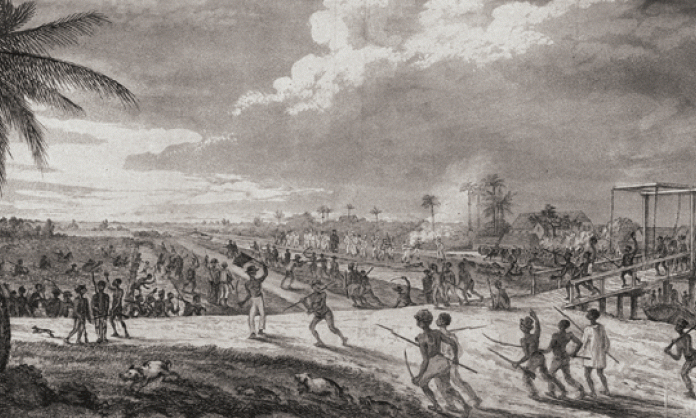“Inequality is not only natural and inborn, it grows with the complexity of civilization,” wrote the late US historian William Durant. “Economic development specialises functions, differentiates abilities, and makes men unequally valuable to their group.”
It is common sense that inequality is inescapable. We’re told that there have always been rich and poor; there will always be haves and have-nots.
Yet history presents a different picture. For more than 150,000 years, 95 percent of human history, egalitarian societies were the norm.
“People lived for millennia in small-scale kin-based social groups, in which the core institutions of economic life included collective or common ownership of land and resources, [and] generalised reciprocity in the distribution of food,” writes Richard Lee, a professor of anthropology at the University of Toronto.
Lee observed the hunter-gatherer Ju/’hoansi/!Kung people of the Kalahari Desert and found that everything is shared, from food to weapons to land. To ensure everyone consumes an equal amount, the most successful hunters are never in charge of handing out the spoils of the hunt.
Similar measures to enforce equal distribution have been observed by anthropologists in most hunter-gatherer societies that remain today.
This in itself challenges the idea of inequality as a natural phenomenon.
The complex history of how humans organised themselves in relation to their changing environment further proves this.
New research by Brian Hayden, professor of archaeology at Simon Fraser University, shows that an ancient hunter-gatherer society in Canada’s northwest shifted between equality and inequality depending on the level of abundance.
When food was in good supply, the groups closer to resource-rich areas enjoyed surpluses, ate better and held feasts to showcase their success. When scarcity crept in, “the majority simply [took] what they need,” writes Hayden. “Scarcity breeds revolts and demands for more equality.”
With the development of new tools and climatic changes, new ways of living began to emerge about 10,000 years ago. Crop cultivation and domestication of animals marked the beginning of human domination over the environment. Societies grew from tens to hundreds to thousands. They began to establish small villages.
This led to radical changes in how people planned and socialised, but did not mean they immediately abandoned egalitarianism.
Anthropologist Edward Evans-Pritchard observed the Nuer people of South Sudan combining agriculture and accumulation of cattle with equal sharing of food and resources.
“The whole community is seen to be partaking of a joint supply,” he wrote. “Rules of hospitality and conventions about the division of meat and fish lead to a far wider sharing of food than a bare statement of the principles of ownership would suggest.
“In general it can be said that no one in a Nuer village starves unless all are starving.”
Over thousands of years, agriculture advanced and expanded, producing for the first time a differentiation in social status. Leaders emerged who gained greater prestige in the community and hereditary lineages were established. Still, egalitarianism proved hard to shake.
Unlike today, the leaders did not enjoy the surplus while others worked creating it. Instead, it was their responsibility to ensure that the community thrived. This meant they were held accountable by those below them.
Studying the Nambikwara of South Africa, Lee observed: “Generosity is … an essential attribute of power.” The chief was expected to allocate the surplus under his control to every individual and family according to their needs.
Lee rejects the idea that different abilities and leadership coincide with inequality: “Much of what tribute the chiefs receive is redistributed to subjects, and the chiefs’ powers are subject to checks and balances by the forces of popular opinion and institutions.”
Societies arranged around similar customs continued to exist for 5,000 years until the creation of the first cities.
What is now known as the “urban revolution” came about through advances in technology that greatly increased agricultural output and the capacity for long-term food storage. Sudden famines and environmental disasters, which previously could wipe out villages in an instant, were now far less common.
British Marxist Chris Harman explained the impact of these advancements on social relations in A people’s history of the world. “The storehouses and their controllers came to seem like powers over and above society, the key to its success, which demanded obedience and praise from the mass of people.”
Previously, there was scarcely time to focus on anything but survival. But this new layer had a space opened to cultivate language and culture while living off the labour of the majority. In such a way, the basis for inequality was established.
Most history books will end the story here. But if inequality is not natural or inevitable, the most important point is that it doesn’t have to exist. It can be challenged. That’s precisely what we see throughout history: the rise of civilisations and inequality has always coincided with resistance – from slave revolts in the Roman Republic, to feudal peasant uprisings, to the strikes and sabotage of the early workers’ movement.
Today, capitalism has created abundance, yet there is scarcity for so many. It isn’t natural. If we build a new movement to create a socialist society, we can end it. We have nothing to lose, and a world to win.










